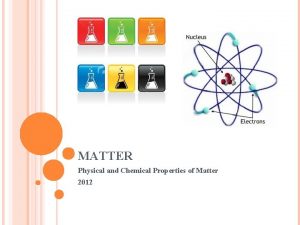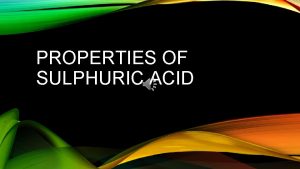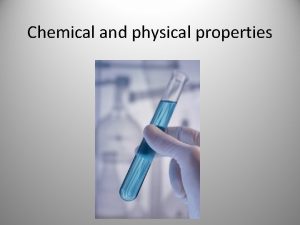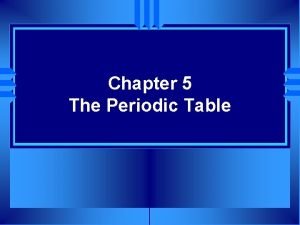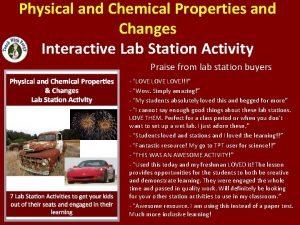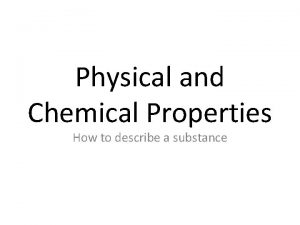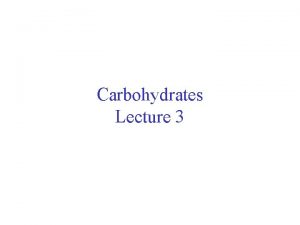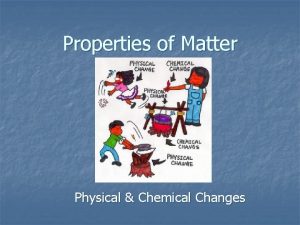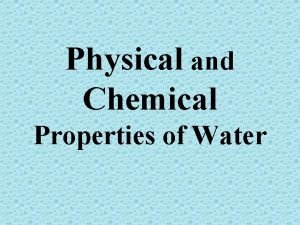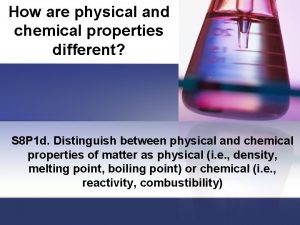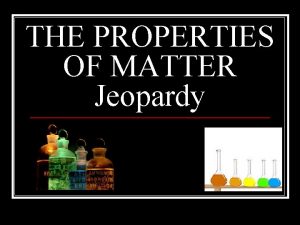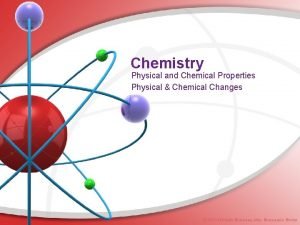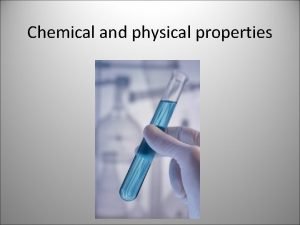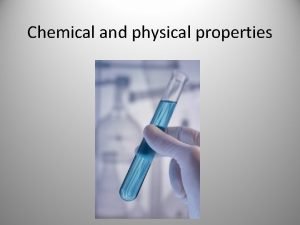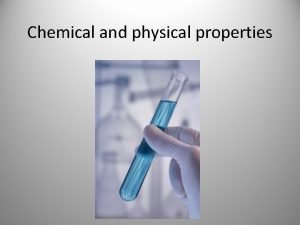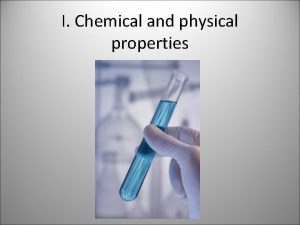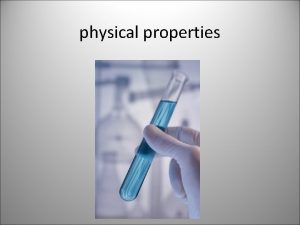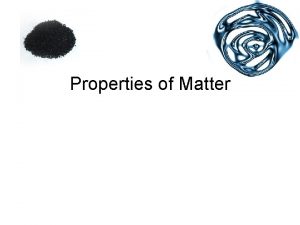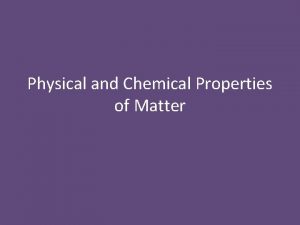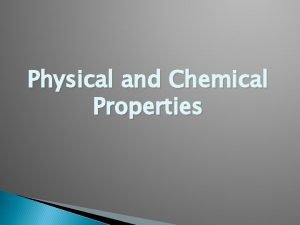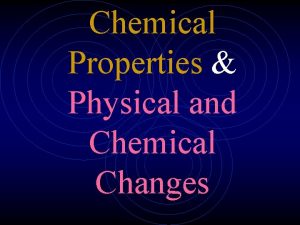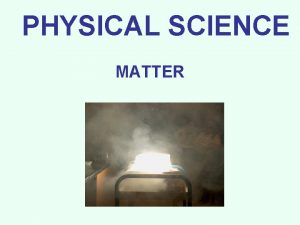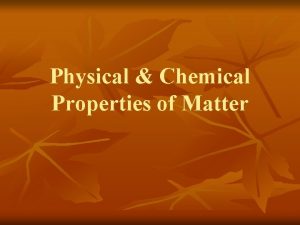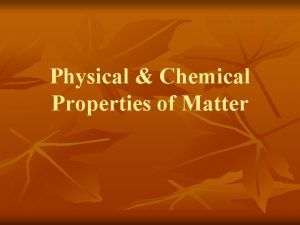Chemical and physical properties Matter Every elementcompound is






















- Slides: 22

Chemical and physical properties

Matter • Every element/compound is unique in some way from all others. • If you know enough about a substance, you can figure out what it is. • If you know what a substance is, you can know all types of things about it.

Matter • All matter has 2 types of properties: Physical properties and chemical properties.

Physical properties • A physical property is a characteristic of a substance that can be observed without changing the substance into another substance. – (You can see it without changing what you’re looking at into something else. )

Physical Properties • Physical properties can be extensive or intensive: – Extensive properties depend on the amount of a substance that you have. – Intensive properties don’t depend on how much you have.

Physical Properties - Examples • Examples of extensive physical properties include: – – Volume Mass Weight Size

Physical Properties - Examples • Examples of intensive physical properties include: – Density – Melting point – Boiling point

• Physical Properties - Examples Other physical properties include: – Color – Hardness – Odor – Taste – State of matter – Texture – Luster (shine) – Flexibility – Heat conductivity – Electrical conductivity – Solubility (ability to dissolve in water. ) – Shape – Viscosity – Ductility – Malleability

Physical properties • List as many physical properties as you can for this item

Chemical properties • A Chemical property is a characteristic of a substance that can only be observed by changing it into a different substance.

Chemical properties - Examples • Examples of chemical properties include: The ability to burn Ability to tarnish Ability to rust Ability to decompose Ability to react with other chemicals – Instability – Ability to do acid/base reactions – – –

Chemical properties • List as many chemical properties as you can for this item.

Chemical and physical properties – So what? • Titanium is very strong and doesn’t rust, so it is often used in jet engines. • Titanium is also nonallergenic. This, combined with the fact that it is rust proof makes it great for artificial joints as well as piercings.

Chemical and physical properties – So what? • Tungsten is usually used as the filament in lightbulbs because it has the highest melting point of any metal. • It glows red hot when electricity runs through it, and it gives off both heat and light.

Chemical and physical properties – So what? • Vanadium is heavier and harder than titanium, so mixing a tiny bit of vanadium with steel can make cheap tools that are still very strong.

Chemical and physical properties – So what? • Helium is almost completely nonreactive (inert). • It is lighter than air, so it’s great for floating balloons (or making funny voices. ) • When electricity runs through helium, it glows a creamy pale peach color.

Chemical and physical properties – So what? • In 1943, all US pennies were made of zinc plated steel because copper was being used in the war. The pennies had to be coated with zinc because steel will rust, but zinc won’t.

Chemical and physical properties – So what? • Sulfur smells awful. Rotten eggs, onions, and garlic all have sulfur in them. Stink bombs use sulfur to create a bad smell. • Sulfur is also flammable, and it is one of the 3 main ingredients in gun powder.

Chemical and physical properties – So what? • Chromium is famous for its intense luster. Chrome plated tools, jewlery, silverware, or car parts are very popular.

Chemical and physical properties – So what? • Most bullets are made of lead because lead is a very dense metal. These bullets are required, by international law, to be coated with a different metal because lead has such a low melting point and is so malleable.

Chemical and physical properties – So what? • The most dense elements are Iridium and osmium which have a density of about 22. 6 g/cm 3

Element abundance • The most common element in the universe is Hydrogen (about 75%), and Helium (about 25%). • The most common element on Earth is Oxygen (46. 6%), and Silicon (27. 7%). • The most common element in your body is Oxygen (65%), and Carbon (18%)
 Physical property and chemical property
Physical property and chemical property True or false: chemical and physical changes alter matter.
True or false: chemical and physical changes alter matter. Measurable properties of matter
Measurable properties of matter Chemical properties of matter
Chemical properties of matter Properties of sulphuric acid
Properties of sulphuric acid Ethan is observing chemical and physical properties
Ethan is observing chemical and physical properties Physical and chemical properties of dental materials
Physical and chemical properties of dental materials Changes of matter examples
Changes of matter examples Helium physical and chemical properties
Helium physical and chemical properties Physical and chemical properties of boron
Physical and chemical properties of boron Physical and chemical properties interactive
Physical and chemical properties interactive Physical properties of sodium
Physical properties of sodium Physical properties of monosaccharides
Physical properties of monosaccharides Physical property
Physical property Water chemical and physical properties
Water chemical and physical properties Physical and chemical properties sorting activity
Physical and chemical properties sorting activity Physical properties of matter jeopardy
Physical properties of matter jeopardy Matter graphic organizer
Matter graphic organizer Chemical properties of notebook paper
Chemical properties of notebook paper Physical/chemical changes & properties color by number
Physical/chemical changes & properties color by number Every nation and every country has
Every nation and every country has Microsoft's mission statement
Microsoft's mission statement Every nation and every country
Every nation and every country


